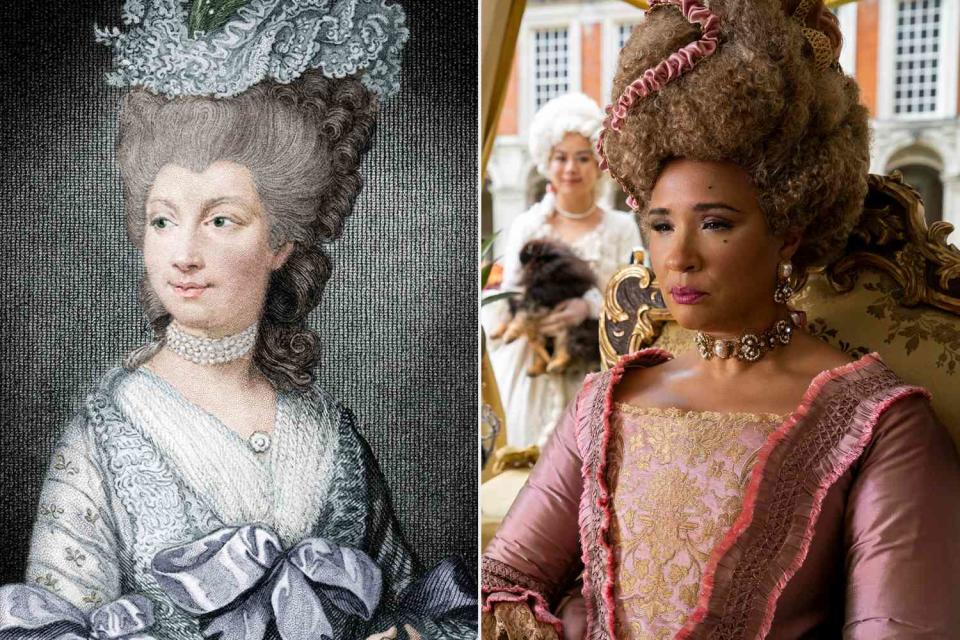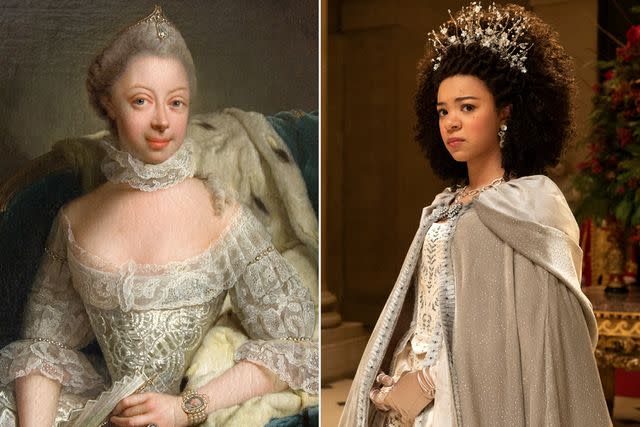All About the Real Queen Charlotte Who Inspired the 'Bridgerton' Spinoff Series
- Oops!Something went wrong.Please try again later.
- Oops!Something went wrong.Please try again later.
- Oops!Something went wrong.Please try again later.
Queen Charlotte was Britain's longest-serving queen consort and made her mark on royal history

Queen Charlotte is taking center stage in Netflix's Bridgerton spinoff, Queen Charlotte: A Bridgerton Story.
The series, starring both India Ria Amarteifio and Golda Rosheuvel as the royal at different parts of her life, documents Queen Charlotte's time on the throne as well as her love story with King George III (played by Corey Mylchreest and James Fleet).
Though the series takes license by dramatizing certain aspects of her life, it is loosely based on the real-life Queen Charlotte of Mecklenburg-Strelitz, who lived during the 18th century.
She was queen for nearly 60 years and lived a fascinating life until her death in 1818. In addition to being Britain's longest-serving queen consort, she made her mark on royal history in many different ways with her contributions to society.
From her upbringing to her relationship with King George, here's everything to know about the real-life Queen Charlotte.
Related:Bridgerton's Golda Rosheuvel on Showing Queen Charlotte's Softer Side: It 'Makes Her Relatable'
She was believed to be biracial
Though she was born in Germany, the daughter of a Duke, Queen Charlotte was directly descended from Margarita de Castro y Sousa, which was the Black branch of the Portuguese Royal House.
While her racial background can't be entirely confirmed, art historians who studied portraits of Charlotte more closely following her death seem to believe she was biracial. In that era, artists typically were encouraged to downplay features deemed "undesirable" — which, during that time's largely prejudiced society, often included those that were considered more traditionally African, according to The Guardian.
However, one painter Sir Allan Ramsay, who was staunchly against slavery (and was married the niece of Lord Mansfield, a judge who ruled in the first case that eventually led to the end of slavery in the British Empire), painted several portraits of Charlotte, which people believe may be more reflective of her actual appearance.
She was 17 when she married King George III
Charlotte got married when she was 17 and George was 22 years old. In July 1761, George announced his intentions to wed Charlotte. A marriage contract was signed a month later and the two eventually wed in London on Sept. 8, just a few hours after her arrival, per The Royal Household website. Their Coronation took place later that month, on Sept. 22.
She had 15 children

Less than a year after getting married, Charlotte and George welcomed their first child together in August 1762, the Prince of Wales, who would later become King George IV. In total, they had 15 children together, 13 of whom survived to adulthood.
In addition to being the grandmother of Queen Victoria, who was the Queen of the United Kingdom of Great Britain and Ireland from 1837 until her death in 1901, she was also the great-great-great-great-grandmother of Queen Elizabeth II.
She and King George III purchased several notable royal homes
Some famous royal homes are all thanks to Charlotte and George, including Buckingham Palace. Though St James's Palace was the official residence of the royal couple, George purchased a nearby property, Buckingham House, which the couple moved into in 1762, making it Buckingham Palace, per The Royal Household website.
Additionally, Charlotte purchased Frogmore House in 1792 as a country retreat for her and her unmarried daughters. The home also played a key role in the celebration of King George III's Golden Jubilee in 1809.
Related:Where Does the Royal Family Live? Everything to Know About Their Residences
She introduced the Christmas tree to Britain
Charlotte has been credited with introducing the Christmas tree to Britain and its colonies. In her hometown of Mecklenburg-Strelitz, it was a tradition to decorate a single yew branch, but Charlotte took it one step further by replacing the branch with a complete tree and decorating it with lavish decorations, The Independent notes.
She founded a number of orphanages
Charlotte had many patronages, and among them were several orphanages she founded. In 1809, she became the patron of the General Lying-in Hospital, a hospital for expectant mothers. It was subsequently renamed as the Queen's Hospital, but today is known as Queen Charlotte's and Chelsea Hospital.
Related:Where Are Royal Family Members Buried? All About Queen Elizabeth and Others' Final Resting Places
She died a year before King George III
Charlotte died on Nov. 17, 1818 at age 74 with her eldest son, the Prince Regent, by her side. She was later buried at St George's Chapel, Windsor Castle. To this day, she is the longest-serving female consort and second-longest-serving consort in British history (after Prince Philip, Duke of Edinburgh).
Over a year after her death, King George III died from pneumonia on Jan. 29, 1820, at age 81. Due to his illness, it's likely that he was not aware of or capable of understanding Charlotte's death in his final years. He was later buried at St George's Chapel, Windsor Castle.
George was succeeded in turn by two of his sons, George IV and William IV, however, both of them died without legitimate children. As a result, his son Prince Edward's only legitimate child, Victoria, took the throne.
For more People news, make sure to sign up for our newsletter!
Read the original article on People.

